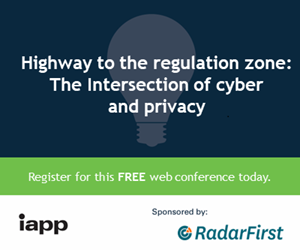Sagi Leizerov and Ken Askelson
The American Institute for Certified Public Accountants (AICPA) and the Canadian Institute for Chartered Accountants (CICA) have updated the Privacy Framework. The groups also decided to refer to the framework as the Generally Accepted Privacy Principles (GAPP, pronounced ga-pi).
Members of the AICPA task force that developed and updated the GAPP have presented it in pre-conference sessions during the IAPP's National Summit in March 2005 and again this year during the conference in Washington, D.C. Many IAPP members are familiar with the principles, but a quick refresher about this framework of privacy principles and criteria may be useful.
GAPP, then the Privacy Framework, was developed by the AICPA and CICA to serve as a benchmark for good privacy practices. The Framework can be used to guide and assist an organization as it implements privacy programs. GAPP contains 10 privacy principles and related criteria that are essential to the proper protection and management of personal information. These privacy principles and criteria are based on internationally known fair information practices included in many privacy laws and regulations of various jurisdictions around the world and recognized good privacy practices.
The 10 privacy principles are Management, Notice, Choice and Consent, Collection, Use and Retention, Access, Disclosure to Third Parties, Security, Quality, Monitoring and Enforcement. For each of the 10 privacy principles, there are relevant, objective, complete and measurable criteria to evaluate an entity's privacy policies, communications, and procedures and controls. The criteria can be further used by auditors to conduct and report on privacy audits. Since its release in 2003, the Framework has become widely accepted and used as the basis for independent privacy audits by several large organizations in the U.S. and Canada by commercial entities during development of products and services, and by businesses as a benchmark in creating internal privacy practices.
The New Release
Some editorial changes were made to the criteria in GAPP, but no substantive changes were made to the criteria or principle, and no new principles were added during the review. In addition to the name change, other changes include its availability in two versions, one for business and management and another for CPAs in public practice who provide consulting and auditing services. The principles and criteria in both versions are the same, but the discussion and additional information provided are different. GAPP expands on the framework to directly address marketplace trends such as outsourcing and the growing international focus on privacy. The complexity surrounding outsourcing increases when the entity that performs the outsourcing service is in a different country and may be subject to different privacy laws or often, no privacy requirements at all. In these circumstances, the organization that outsources a business process will need to ensure that it manages its privacy responsibilities appropriately.
Since the GAPP principles and criteria are based on internationally known fair information practices included in many privacy laws and regulations of various jurisdictions around the world and recognized as good privacy practices, it may be applied globally. For example, an organization may use GAPP in completing privacy assessments (including independent audits) of an entity performing outsourcing activities for them.
The Practitioner version of GAPP for CPAs/CAs in public practice expands on various auditing considerations and provides examples of audit reports appropriate for both U.S and Canadian audit engagements. The document also provides guidance for auditors on various audit engagements for privacy. Although it is directed at auditors, we believe many non-auditors will find this guidance helpful. If you are considering an audit in your organization, or if you know that such an audit is imminent, whether internal or external, the guidance provided in this version will be helpful and interesting.
The GAPP and You
The GAPP can help privacy professionals in many different ways. It can serve as the basis for strategic planning of privacy activities. Relying on its criteria as well as the illustrations and explanations that accompany each of the criterions, privacy professionals and management alike can identify the various steps they should take to further enhance their privacy management. Similarly, the GAPP can be used to benchmark an organization's privacy standing. The GAPP is especially helpful when conducting an internal risk assessment. The information accompanying each of the 10 principles allows organizations to assess the privacy management risks an organization faces.
Furthermore, the GAPP is equally useful as a resource for internal auditors and external auditors.
The GAPP is the de-facto standard for auditing for privacy management. Privacy professionals who address the principles and criteria detailed in GAPP in their privacy program are likely to have a more robust and comprehensive program, making them more prepared when auditors come knocking.
A downloadable version of GAPP, along with additional information about the development and additional privacy resources, can be found at www.aicpa.org/privacy `and www.cica.ca/privacy.
Sagi Leizerov, CIPP, Ph.D. is a Senior Manager with Ernst & Young LLP. He helps lead the firm's Privacy Assurance and Advisory Services Practice. Leizerov is a member of the AICPA/CICA Privacy Task Force that developed and updated the GAPP.
Ken Askelson, CPA, CITP, CIA is Senior IT Audit Manager with JCPenney Company. He also is part of the team that provides oversight for the organization's privacy program and practices. Askelson is Vice-Chair of the AICPA/CICA Privacy Task Force that developed and updated the GAPP.






























Comments
If you want to comment on this post, you need to login.